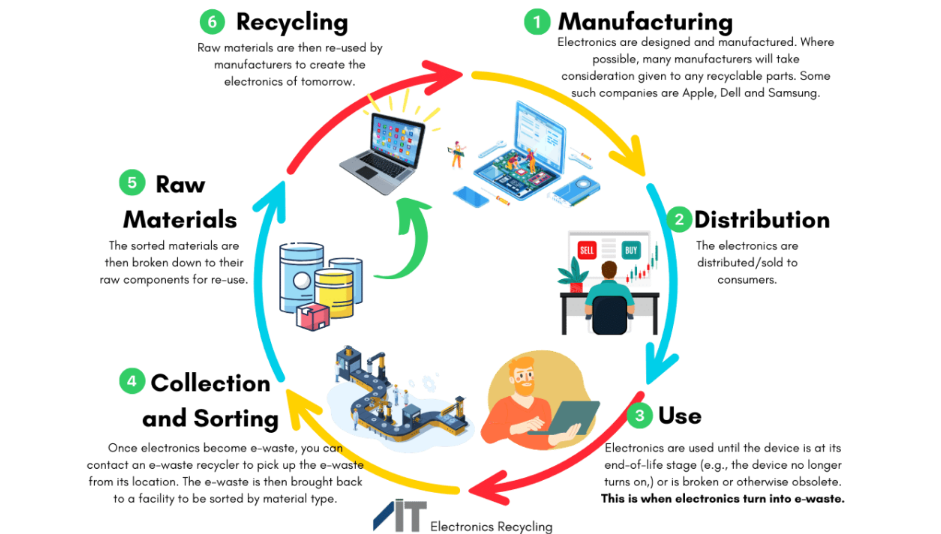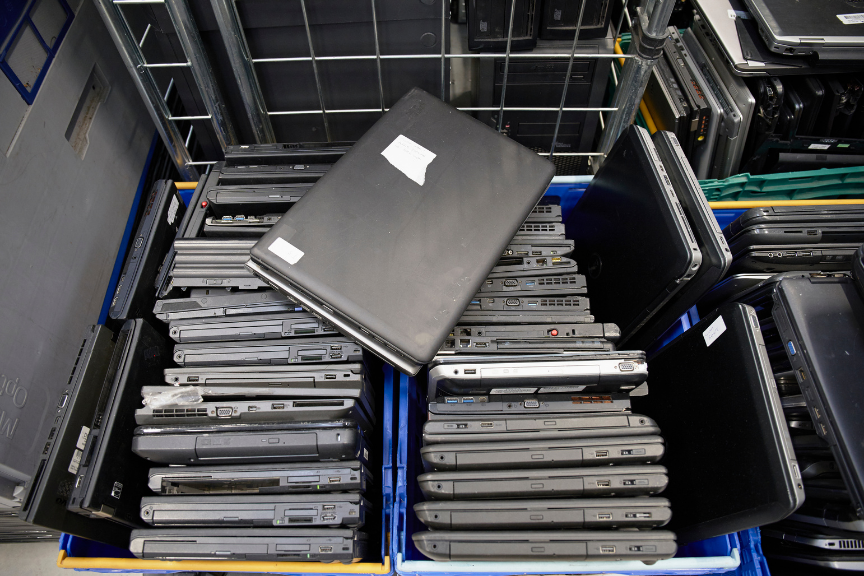Your company’s electronics – from laptops and servers to mobile phones – is the engine of its daily operations. But what happens when that technology reaches the end of its road? Too often, old hardware is forgotten in a storage closet or, even worse, tossed in the trash. This linear “buy, use, dispose” model is not just wasteful; it’s a missed opportunity. Building a sustainable IT asset lifecycle is about creating a circular system that maximizes value, minimizes waste, and enhances your company’s bottom line.
This article provides a practical roadmap for integrating recycling and IT Asset Disposition (ITAD) into your hardware management strategy. We will explore actionable steps to transform your approach to technology, turning a cost center into a source of value and a testament to your corporate responsibility.
Learn more about AIT’s IT asset management services here
Why a Sustainable IT Lifecycle Matters
Managing IT assets sustainably goes beyond simply recycling. It’s a strategic business decision with far-reaching benefits. A well-planned lifecycle reduces security risks from improperly handled data, recovers financial value from used equipment, and ensures compliance with environmental regulations.

Step 1: Conduct a Comprehensive IT Audit
You can’t manage what you don’t measure. The first step toward a sustainable lifecycle is to get a clear picture of all the technology your company owns. A thorough IT audit involves creating a detailed inventory of every asset, from servers and desktops to monitors and cables.
For each asset, you should document:
- Asset type and model
- Serial number
- Purchase date and cost
- Current status (in use, in storage, awaiting disposal)
This audit provides the data needed to make informed decisions. It helps you identify underutilized equipment that can be redeployed, assets nearing the end of their useful life, and devices that are ready for disposition. Regular audits – at least annually – keep your inventory current and your lifecycle plan on track.
Try our ITAD calculator to receive an instant estimate for your ITAD’s resale value
Step 2: Establish a Clear ITAD Policy

Once you know what you have, you need a formal plan for handling it. An IT Asset Disposition (ITAD) policy is a set of guidelines that standardizes how your company retires and disposes of technology. This policy should be a clear, written document accessible to all employees, particularly those in IT and procurement.
Your ITAD policy should define procedures for:
- Data Destruction: Mandate how sensitive data will be securely erased from all devices before they leave your premises.
- Decommissioning: Outline the process for collecting, inventorying, and preparing assets for pickup.
- Vendor Selection: Set criteria for choosing a certified ITAD partner.
Having a formal policy eliminates guesswork, ensures consistency, and minimizes the risk of a costly data breach or compliance violation.
Step 3: Partner with a Certified ITAD Vendor
Choosing the right ITAD partner is the most critical part of this process. A qualified vendor does more than just haul away old electronics; they become an extension of your IT and compliance teams. They manage the complex logistics of asset reselling, certified data destruction, and responsible recycling.
AIT will provide a complete chain of custody and detailed documentation, including Certificates of Data Destruction and Recycling. This audit trail is your proof of due diligence and regulatory compliance.
Learn more about AIT’s regulatory compliance and reporting here
Step 4: Maximize Value Through Refurbishment and Resale

Not all retired IT equipment is junk. Many devices retain significant residual value. A strategic ITAD program focuses on recovering this value through refurbishment and resale. Your ITAD partner can assess your used assets and identify those with market value.
This process typically involves:
- Testing and Grading: Technicians test each device to determine its functional condition and cosmetic grade.
- Data Destruction: All data is securely destroyed to NIST and IEEE standards.
- Refurbishment: Minor repairs or upgrades are made to increase the asset’s value.
- Resale: The refurbished equipment is sold through secondary markets, and a portion of the proceeds is returned to your company.
This approach turns a disposal cost into a revenue stream, helping to fund new technology purchases and reduce the total cost of ownership.
Learn more about the ITAD strategy here
Try our ITAD calculator to receive an instant estimate for your ITAD’s resale value
Step 5: Implement and Promote Your Program
With your policies in place and a partner selected, it’s time to launch your program. Communication is key: ensure all employees understand the importance of the new IT lifecycle process and their role in it.
AIT creates a simple process for employees to request pickup and recycling of old equipment. Simply reach out to us when a pickup is required, and we’ll be there!
The Rewards of a Sustainable IT Lifecycle
Adopting a sustainable approach to IT asset management delivers compounding benefits. It significantly reduces the risk of a data breach, which can cost millions in fines and reputational damage. By recovering value from old hardware, you lower the total cost of technology ownership and free up budget for innovation.
Most importantly, you build a more resilient and respected brand. A clear commitment to environmental responsibility resonates with customers and solidifies your reputation as a forward-thinking leader. By closing the loop on your IT lifecycle, you protect your business, your data, and the planet.